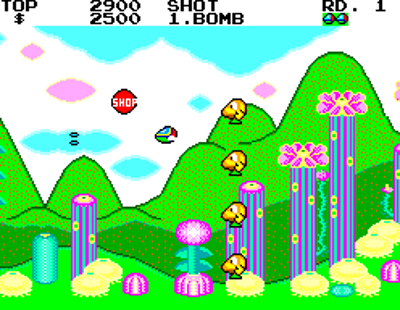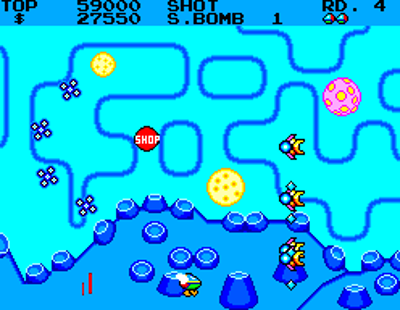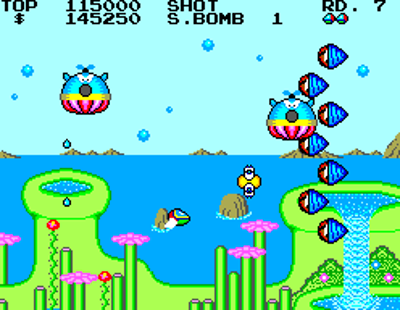I love the graphics in this game. I've played it in Sonic's Ultimate Genesis Collection and Sega Classics Collection. I should go play it now.
Fantasy Zone Review Rewind
|
|
See PixlBit's Review Policies

On 11/18/2021 at 10:25 AM by Jamie Alston Cute but Deadly |

A good choice if you’re looking for a unique shoot-’em-up that’s not a bullet hell gauntlet.
After seeing the incredible success of Konami's shoot-'em-up Gradius, Sega sought to create an arcade game that could rival it. So in 1986, game designer Yoji Ishii (Flicky, Outrun, NiGHTS) came up with a concept that combined the whimsical sensibilities of Twinbee with a giddy samba-esque soundtrack to create Fantasy Zone. As a lighthearted take on side-scrolling shooters that later cemented the "cute-’em-up" subgenre.
As it became a hit in Japan, Sega found new success where it previously eluded them. Soon to be ported to a string of home video game consoles, the Sega Master System (SMS) was #1 on the priority list. Only in the last 15 years or so have I been personally acquainted with the series. But I could quickly see why this Fantasy Zone was a worthy mascot for Sega.

The game's plot involves an economic crisis of sorts. Invading aliens try to take over the Fantasy Zone by using embezzled foreign money to build their forces. You play as Opa-Opa- the sentient spaceship with expandable abilities. Opa-Opa must travel to eight planets in the solar system and destroy the bases on each planet while collecting as much money as possible. That's it in a nutshell.
The arcade version of Fantasy Zone was in a league of its own, running on Sega's new System 16 board which powered the vibrant pastel colors. While the SMS port cannot deliver the same caliber of graphical and audio prowess, it retains the core gameplay elements that make it fun to play. You can fly either left or right in a free-roaming style reminiscent of Defender, which may take time getting used to if you're a first-time player.
Opa-Opa himself is a unique protagonist. He's a small pod-shaped spacecraft with wings and sprouts little legs to walk when trekking the surface. Those features are a nice touch that lends itself to the overall cuteness of the game. The design also gives Opa-Opa a certain quality of character that you can't help but love. It was a refreshing change from the self-serious character designs in other games at the time.

The primary objective is to destroy the bases on each planet and defeat the boss for that area. Akin to games like Xevious and Twinbee, you start with a default twin shot and single bomb projectile. Acquiring powerups requires collecting money from fallen enemies and purchasing upgrades from a shop that appears periodically on most levels. There are many upgrades to choose from, with the caveat that the primary weapons are bound to a time limit (about 15 seconds) before returning to the default armament. Thankfully, a yellow "select" balloon floats down to allow you to switch to another weapon if you've purchased multiple items.
Offering powerups via a monetarily-based upgrade system was a new concept to shoot-em-ups and introduced an additional layer of strategy to players' decisions. Each time you purchase a weapon or extra life, the price of that item increases. A wise player may forgo buying any major upgrades until later in the game to save the cash for when they need it. And should you die at any point, you lose whatever upgrades you purchased. But the prices still stay at wherever rate they were after you bought that item. It's a neat risk/reward concept that raises the stakes, especially near the end of the game.

Don't be fooled by the pastel surroundings- underneath that cutesy Candy Land exterior hides a demanding excursion that requires some precise reflexes. This game will quickly pound you into the ground if you're not careful, due in part to the free-roaming ability to scroll the screen in either direction horizontally. The camera doesn't allow you to see too much of what's ahead of you, so you can quickly smack into an enemy or bullet. And suffice it to say, some of the enemy patterns are pretty pesky. They tend to appear in clusters at the most inconvenient of times. But these moments were intentionally put there to encourage the player to take their time and shoot down the smaller enemies first rather than blitzing through all the bases.
As expected when porting an arcade game to an 8-bit console, the graphics had to take one for the team. The bases are no longer animated; they're just static images, which makes some of them easy to blend into the background or otherwise crash into accidentally. The bar meter for your upgraded weapon is replaced with a simplistic numerical timer. And the radar that shows the location of each base is a no-go on the SMS as well. But it isn't all bad, though. Sacrificing those visual comforts resulted in a clean presentation that feels appropriate for its platform while running almost as smoothly as the arcade version. I dare say that it's one of the best-looking early SMS conversions.

The music was initially composed by Hiroshi Kawaguchi- famed for his breezy tunes in Outrun and other Sega arcade titles. For Fantasy Zone, he crafted a brilliant score with a Latin tropical influence. Tragically, the music loses a bit of its impact on the SMS due to its admittedly inferior audio capabilities. It's missing the heavier bass guitar and synthesizers from the arcade version. Even so, it still retains the fun feel that compliments the visual design. The melodies in the first three stages are my standout favorites.
Despite the noticeable blemishes, Fantasy Zone is still one of my favorite SMS games. The unique character designs, quirky setting, and enjoyable soundtrack make it all the more enticing to play. And while the game can be a bit difficult for beginners, it isn't punishingly so. On the contrary, once you learn the enemy patterns and discover which upgrades work best, you'll last much longer and fly further. So whether you play this particular version, the arcade original, or one of the other versions out there, Fantasy Zone is worth experiencing, especially if you're new to the cute-’em-up genre.









Comments